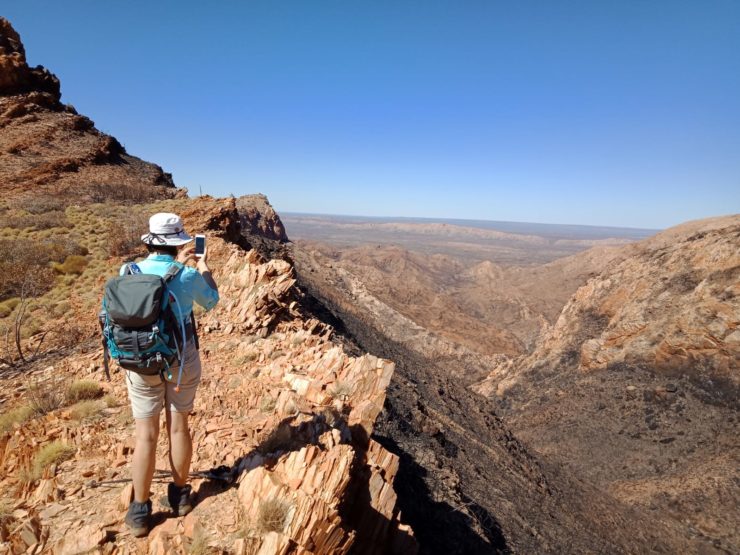How to prepare for the Larapinta Trail

How to prepare for the Larapinta Trail
Posted on
There are heaps of different ways to walk the Larapinta Trail. You could organise the whole trip yourself or go with a guide. Even with a guide, some prefer to hike it as a full pack carry, while others have their gear transported for them and just hit the trail with a daypack. Depending on how much time you have, you might hike the whole trail from end to end or just do a few sections.
Whichever way you hike it, you need to be seriously physically prepared. Believe me. I found this out the hard way when I tore my meniscus on The Razorback (part of Section 4). Fortunately, I was on a guided trip and it was only a minor tear – could’ve been much worse – but it probably could have been avoided if I was more physically prepared.
I’m determined to get my boots back in the red dirt and hike the whole Larapinta Trail one day. When I finally do, I’ll try harder to follow these simple steps for my preparation…
Start training early
You know your body best, so if you’re really out of shape then you’ll already have an idea of how much work you need to do. This will also depend on whether you’re doing a guided tour with only a handful of days on the trail with a daypack, or you’re carrying everything from end to end.
A good guide for people of reasonable fitness is to start training at least 6 weeks out from your trip, but obviously if you expect to go from couch potato to taking on the entire Larapinta Trail you’ll want to think much longer term – 3 to 6 months isn’t a long time to prepare.
Start small and work up to your goal slowly
If you’re out of shape, then at the very least you’re going to want to start spending a lot of your free time walking around the neighbourhood. Sections on the Larapinta Trail range from 10 to 29 kilometres, so covering as much distance as you can is your first concern.
Just pounding the pavement is not going to cut it though. Once you’re used to walking, you need to find some local hiking trails that will allow you to incorporate some hills and rough terrain. You’ll also need to consider the weight you’ll be carrying on your back and carry a similar amount when training.
By the week before your Larapinta trek, you should ideally be carrying the same weight you plan to carry on the trail over rough, hilly terrain for 15+ kilometres.
Work on balance, strength and agility just as much as fitness
Your cardio fitness might be amazing but how’s your balance, strength and agility? Sometimes even fit people get the shock of their lives after a couple of days on Larapinta. You might be used to running marathons but I can’t stress enough how differently the rugged terrain on the Larapinta Trail will effect your body.
Training on the most rugged trails you can find near home will obviously help with this but, particularly if you have a dodgy ankle or a bung knee, you need to start strengthening exercises for the muscles that need it as early as possible. Even if you haven’t had trouble with your ankles and knees in the past, it isn’t a terrible idea to focus on strengthening them before you find out the hard way how much they need it.
Finally, you need to stretch, stretch and then stretch some more. Your flexibility will be crucial to keeping your body safe and well on the trail. Stretch after every walk and every workout during your Larapinta preparation. Once you hit the trail, keep stretching at every opportunity.
Squeeze in gym workouts when you can’t hit the trails
You can’t prepare yourself for a trek like Larapinta by exclusively using the gym. However, when you’re too busy or the weather sucks, there are plenty of equipment-based gym workouts (or even body weight-based home workouts) you can do to improve cardio fitness, strengthen important muscles, and improve balance and agility. It’s easy to make excuses to skip training but you’ll regret it once you’re on the trail.
Talk to a personal trainer at the gym (or even your physiotherapist or osteopath) about which workouts will be best to achieve your goals.
Prepare to sweat
Don’t underestimate the hot, dry days on Larapinta. If you’re not someone who’s in the habit of drinking a lot of water, your training time is a good opportunity to make a habit of it. Get yourself a hydration bladder or a water bottle sling if you need to – whatever works best to encourage you to hydrate.
Dehydration is a very real threat in the desert. Even if it’s overcast and not too hot when you hit the trail, the dry desert air will have you sweating like crazy. The problem is that you may not notice just how much you’re sweating and forget to hydrate.
Make sure your footwear is up to the job and worn in
Decide as long as possible before you hit the trail whether you’re in need of a new pair of hiking shoes or boots. This is not the place to test out a new pair, nor is it the place to discover that your old favourites are well past their prime.
I’m not personally prone to blisters so that wasn’t an issue for me, but I was mid-way through day 2 of my Larapinta trek when I realised my 8 year old hiking shoes had long lost their arch support and underfoot padding, and as a result the rocky terrain was bruising the hell out of my feet.
If you do buy new ones, make sure they’ve done plenty of kilometres on bush trails before you test them out on Larapinta.
Preparation and planning make all the difference when attempting any long hike, but even more so with rugged desert terrain like the Larapinta Trail. So, what are you waiting for? There’s no better time than now to kickstart your training.
-Neil Fahey
Guest blogger from the bushwalkingblog



